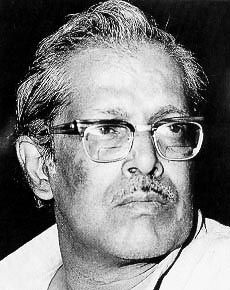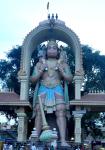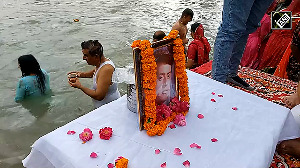 On Hrishikesh Mukherjee's 91st birth anniversary on September 30, we bring back a Rediff Special done on the brilliant filmmaker in December 2002. Read on:
On Hrishikesh Mukherjee's 91st birth anniversary on September 30, we bring back a Rediff Special done on the brilliant filmmaker in December 2002. Read on:
Hrishikesh Mukherjee's cinema could make you cry. You sniffle when Sharmila Tagore's emotionally withdrawn father surmounts his long-festering resentment towards his daughter and comes to the railway station to secretly rejoice in her eloping with her lover in Anupama or when Ashok Kumar opens his heart, overcomes his distaste and makes his daughter-in-law's son, the product of rape, light his son's pyre in Satyakam.
Mukherjee's movies could make you laugh. You chuckle in the Wodehousian comedy of inconsequentialities, Chupke Chupke when Amitabh, posing as a professor of botany, grapples with the word 'corolla' or in Golmaal when a truant moustache leads to many merry muddles.
Sometimes, his films could make you laugh even while you were blinking hard to part the film of tears covering your eyes. Like in Anand, where Rajesh Khanna greets even death with a well-turned bon mot.
Without being aggressively experimental or ostentatiously avant garde in form, theme or treatment, many of Mukherjee's 40-plus films have charmed audiences and critics alike because of their middle-of-the-road accessibility, heart-warming irony and literate sensibilities.
Most of his captivating characters inhabit a middle-class, urban, educated milieu and lightly wear an air of high morality and intrinsic geniality.
Amitabh Bachchan once said, "A director's films reflect his personality."
Mukherjee was a soft-spoken, well-educated professional (he loves a game of chess), who learnt the ropes of filmmaking from venerable institutions like Kolkata's New Theatres and director Bimal Roy. He assisted Roy on classics like Do Bigha Zameen and Devdas.
Roy's influence was evident in Mukherjee's choice of subjects. Mukherjee got to know Dilip Kumar during his stint with Roy and got the star to act in his directorial debut, Musafir (1957), an episodic ensemble drama about six characters and a house.
Mukherjee had obviously made a name for himself as an editor because he got Kishore Kumar, Nirupa Roy, Suchitra Sen and Usha Kiron to costar in the film.
At the box office, Mukherjee hit his stride with his second film, Anari (1959). Studded with hit Shankar-Jaikishen songs, Anari is the well-meaning point of view from a simple, but idealistic young man (Raj Kapoor) disillusioned with the rich (mainly heroine Nutan's uncle, Motilal).
A certain sensitivity and a benign aura (Raj Kapoor sings Kisi ki muskurahaton pe ho nisaar, jeena isika naam hai in Anari), pervaded Mukherjee's cinema from the beginning.
Anari featured Lalita Pawar as Mrs D'Sa, the sandpaper-tongued, but soft-hearted landlady. Mukherjee had such kindly character actors (often played by David) in many of his films. Witness 1971's Guddi where Sumita Sanyal plays Jaya Bhaduri's sweet but not saccharine bhabhi. When Guddi is adamant about wearing a miniskirt, the bhabhi placidly states, "Why would you listen to me? I am just your bhabhi, not your mother."
With minimum fuss, Guddi establishes the depth of their mutual affection by changing into a sari.
After Anari's success, Mukherjee bravely plunged into making small movies like Anuradha (which introduced the lovely Leela Naidu and harnessed maestro Ravi Shankar's composing talents), and Mem Didi (fuelled by Lalita Pawar's star power!) alongside Raj Kapoor and Dev Anand starrers.
Anupama (1966), an intimate look at a daughter's unarticulated anguish at her father's rejection (he holds her responsible for her mother's death in childbirth), and her final assertion of her self, was a burnished gem. Mukherjee continued to take risks and cast Ashok Kumar, by then established as a character actor, as the protagonist of his Aashirwad (another poignant father-daughter tale) and steered him to a Best Actor Award win.
Dharmendra produced Mukherjee's Satyakam and was rewarded with his best performance ever as the straight-backed soldier of truth.
Mukherjee's fame as a director loved by actors was confirmed with two biographical classics in the early 1970s -- Anand and Guddi -- films which boosted Rajesh Khanna and Jaya Bhaduri's careers tremendously.
His films were shorn of affectation so were his heroines. Mukherjee established the girl-next-door look with Jaya in Guddi but his heroines were archetypal even when he worked with glamour icons like Sadhana (sari-wrapped and beguiling in Asli Naqli), and Sharmila Tagore (no outlandish eyeliner in her Mukherjee films). Jaya continued her look in subsequent Mukherjee films like Abhimaan (1973), an astute observation of the attendant ego hassles which rise when a married couple is in the same profession.
Namak Haram, released in the same year, boasted of an explosive performance from Amitabh as a man torn between his friendship with blue-collared worker Rajesh Khanna and his capitalistic ideology. Amitabh continued to work with Mukherjee over the next decade doing seven films in all.
A certain prolificity in Mukherjee's career graph (he had three releases in 1975, Chupke Chupke, Mili and Chaitali), unfortunately led to his reworking several pet themes. Anand's dying male protagonist was transformed into a female cancer patient in Mili. Rekha's exuberant Khoobsurat persona found a faint echo in Jhoothi.
His latest film, Jhooth Bole Kauwa Kaatein was a tepid reworking of his Golmaal.
After two sparkling comedies, Golmaal (1979) and Khoobsurat (1980), Mukherjee's career went into decline. He dabbled with television, was chairman of the National Film Development Corporation and, in 1999, attempted a comeback with Jhooth Bole Kauwa Kaatein.
Ill-health has increasingly curtailed his activities. But this 80 year old, who has been awarded the Padma Vibhushan and the Dadasaheb Phalke Award, can afford to rest easy on his many laurels.











 © 2025
© 2025